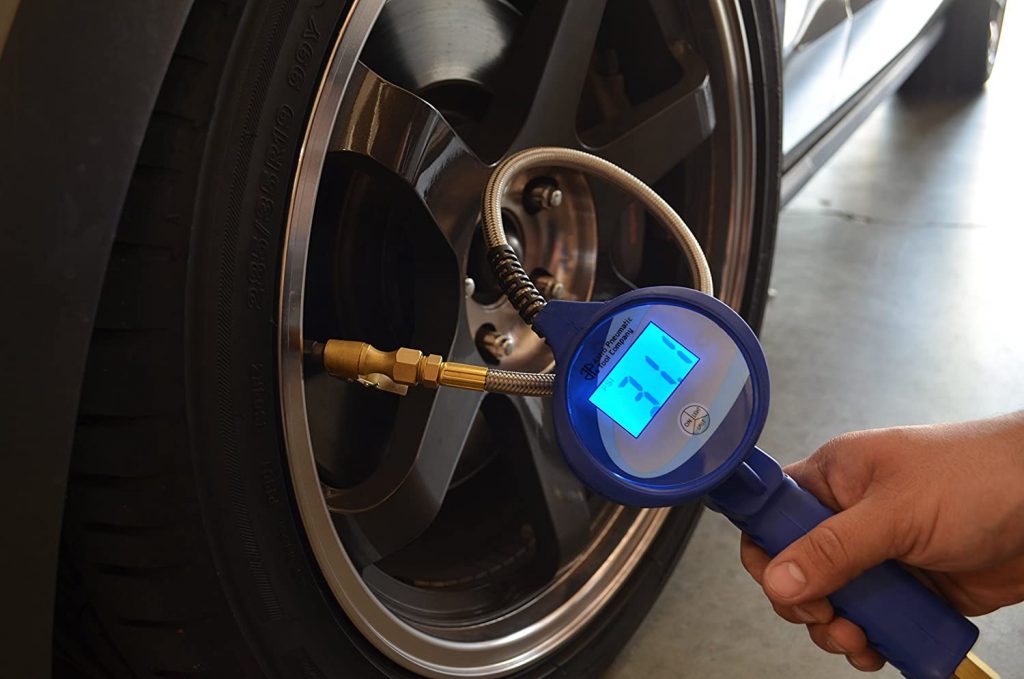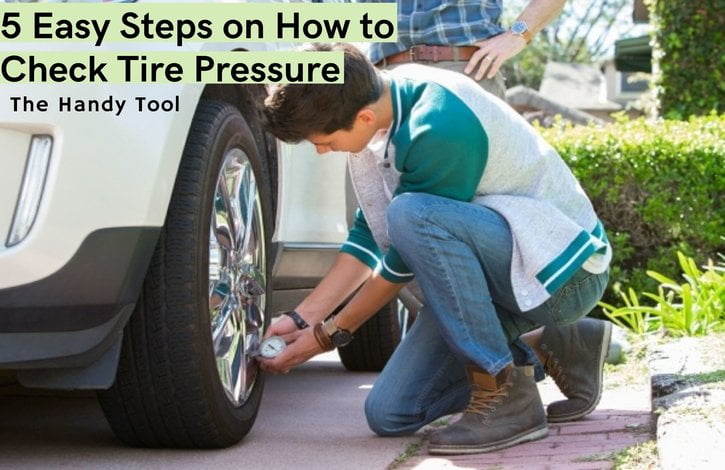You are going to refill your car tires but don’t know how to check tire pressure, you are undoubtedly in a mare’s nest.
But there is no need to be anxious. Because we are here to make your path easier. You will be totally clear about checking tire pressure in the end.
Let’s get into it!
Table of content:
5 Easy Steps of Checking Tire pressure

Here are some steps you have to go through. We tried to make them as simple as we could.
You can follow these steps at your home or at a gas station. So, you will also know how to check pressure at gas stations, no trouble!
Step 1: Know the recommended pressure
You will find the manufacturer’s recommended pressure level in your owner’s manual. In case, the owner’s manual isn’t with you, don’t be worried. You will also find it on the driver’s side door jamb.
You will find something like 28-35 PSI which is your recommended pressure. Remember, you will go by the recommended pressure always. Don’t ever go by the max pressure that is listed on the sidewall of the tire.
Step 2: Make sure the tires are cold
Yes, the ideal time to check your tire is when it’s cold. Otherwise, the extra warm will give extra pressure in your tire and you may get false reading.
Wait at least for 30 minutes after your driving, let the tires cool down and then check the pressure.
Step 3: Choose a pressure gauge
There are three types of available gauge in the market-
The Stick Gauge
This one is inexpensive, easy to use and really small to fit. But this tire gauge can be tricky to read.
The Dial Gauge
Dial gauge gives you more accurate results than the stick gauge and also easier to read the result. But it takes up more space, not so small like a stick gauge.
The Digital Gauge
This will give you the most accurate result. Some of its models are less expensive than dial gauge but a bit expensive than the stick gauge. Above all, this one is very easy to use.
But one thing is, since this type uses batteries, you have to ensure the power isn’t low while taking a reading.
You can pick one from them. If you are in a gas station and don’t have the gauge with you, just take any one kind of gauge from the station.
Step 4: Remove the valve cap
The stem valve caps on your tires are generally black or silver colored. Remove them and put in your pocket for not losing them.
Step 5: Press the tire gauge onto the valve
Press it firmly onto the valve. If you use a stick gauge, be sure that you are using the open end (not the side that releases air).
Now, wait some time for the pressure reading coming on the screen for the digital gauge. In case you are using a dial gauge, wait for the needle to stop. But if it’s a stick gauge, wait until the white colored plastic stick stops moving.
So, that’s how you can get the readings.
Since you are done with checking pressure, you can easily put air in your tires at home, you can put air in tires at a gas and petrol station.
What If You Don’t Want to Use a Gauge?
Okay! There are ways. You can check tire pressure even without a gauge. So yeah, you will know now how to put air in tires without gauge.
1. Hand pressure
Your heel or hand will be used to push the tire hard. Now, FEEL. If you feel like you are hitting a rock then it’s full of air.
But in case, it feels like pushing back then there is low pressure. So, you have to put air in tires right now until you achieve the ‘feel like rock’ level.
2. Eyeballing
This method is risky enough if you aren’t an experienced driver. It’s kind of difficult to observe a difference between 10 to 20 PSI. But still, it’s a process!
For this, position your vehicle on a flat surface like road. Now, observe the tires from some distance and you will find the difference of air pressure in tires.
3. Weight on the wheels
Try to put maximum on the tires. If they have low pressure then surely will deform 10 to 20%. That’s a noticeable deformation which will give you an idea of required air.
Frequently Asked Questions(FAQ)
How do I know if my tire needs air?
Learn the relationship between the feel at your thumb and the amount of pressure in the tire. Moreover, you can use the above-mentioned methods- hand pressure, eyeballing, and weight on the wheels.
How does low tire pressure sound like?
Whenever you hear a noisy sound from the tire, it indicates any unusual happening into it. If there is low pressure you’ll feel a ‘humming’ or like a ‘womp womp’ sound coming from the tires.
How do you know if your tire pressure is low?
When your tire pressure is low, the more of your tire will be touching the ground. You will notice it while eyeballing on the tires.
For being the pressure low, your wheels may wear out and you’ll burn through fuel at a faster rate. Because your car is working harder to keep moving. So, check the tire pressure and refill the tires when needed.
Conclusion
That’s the dead end! As you now know how to check pressure, you might need an air compressor inflater for a low-pressure situation.
However, be careful while going through the steps. Reading it wrong won’t turn good for both you and your car’s safety.
Good luck!

